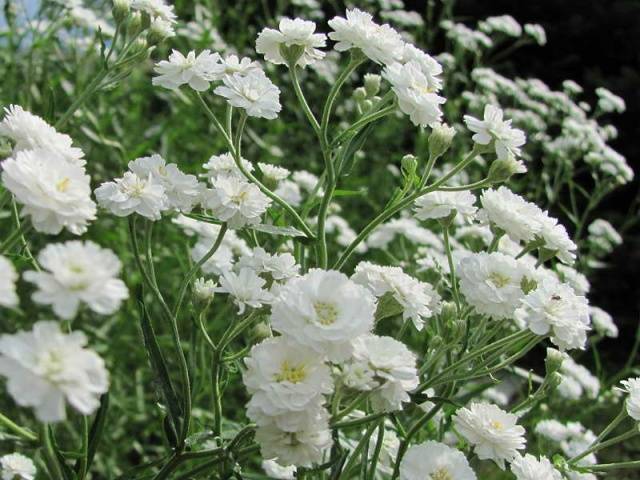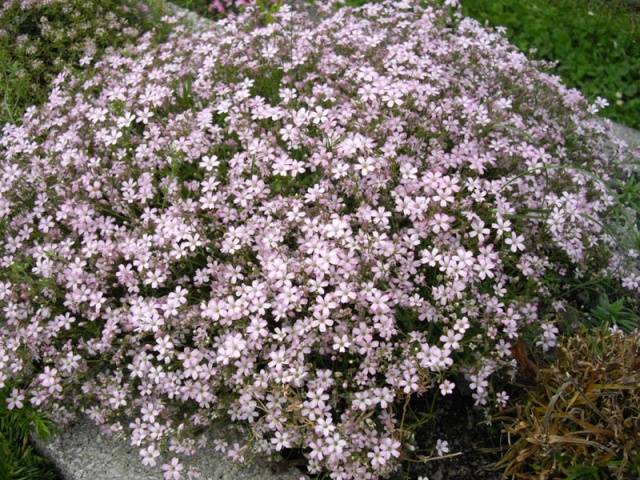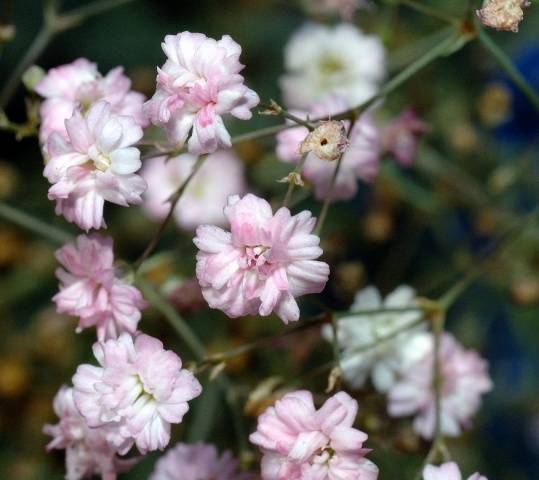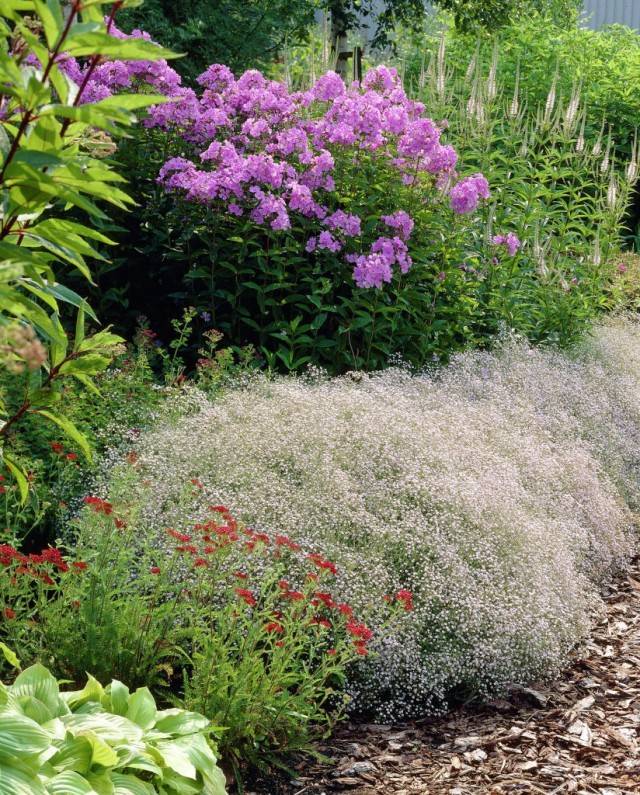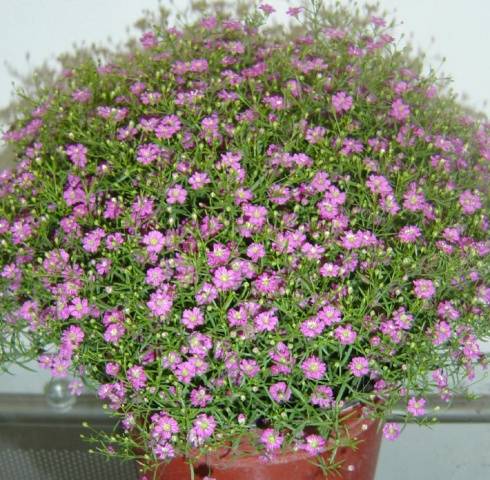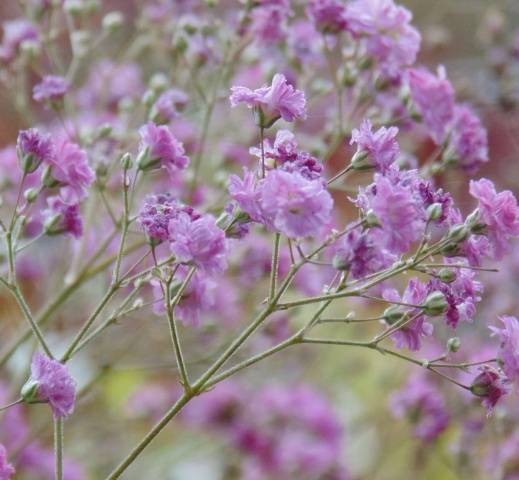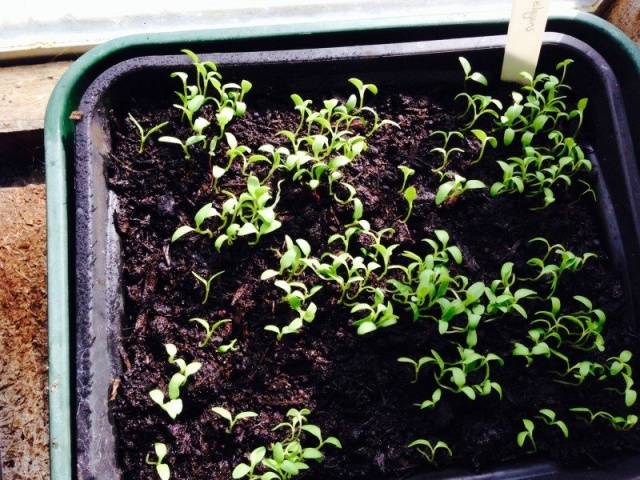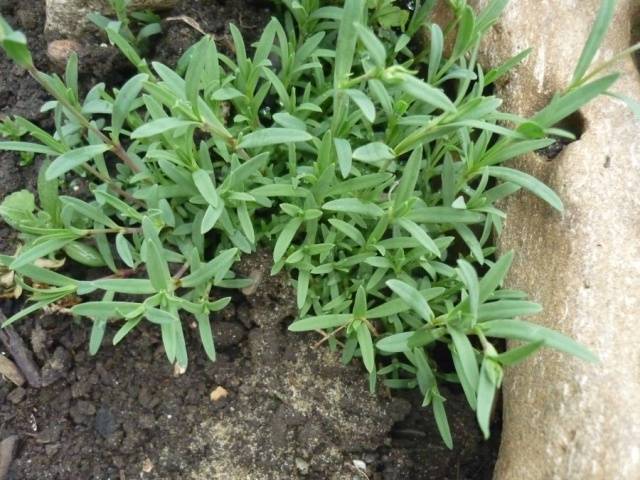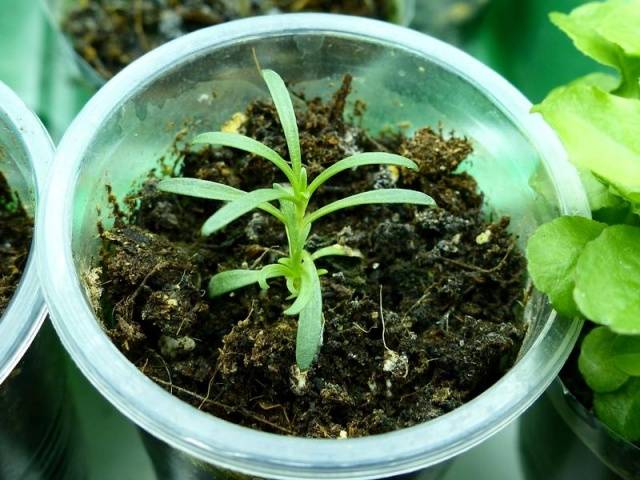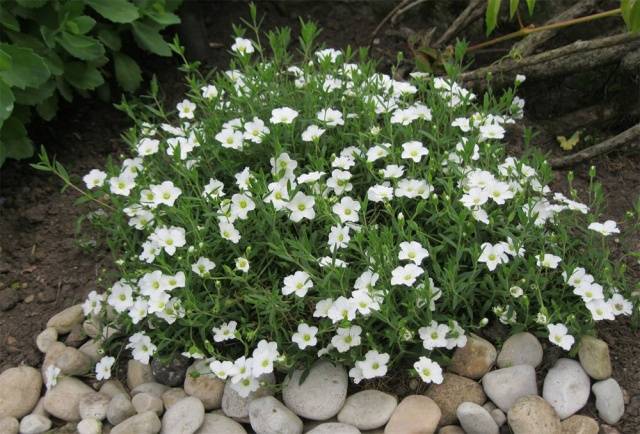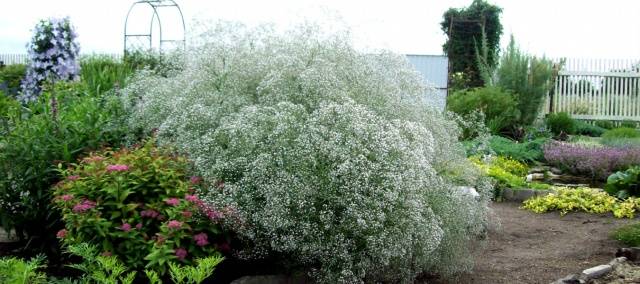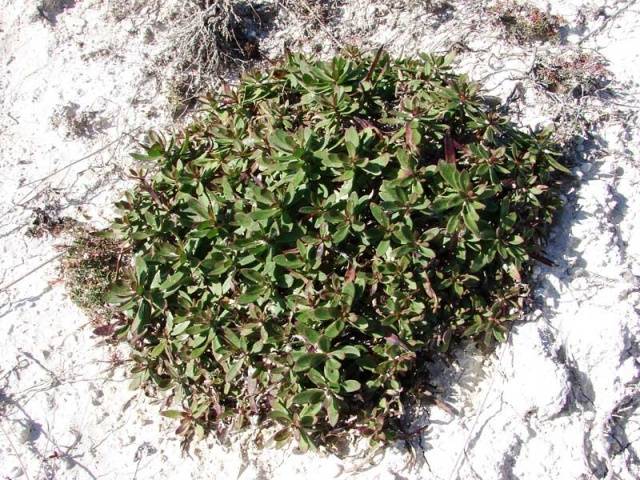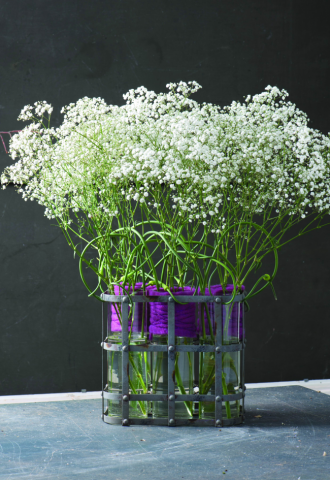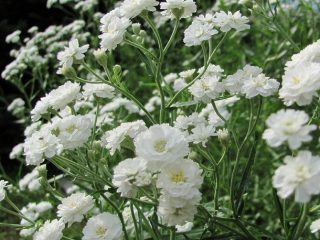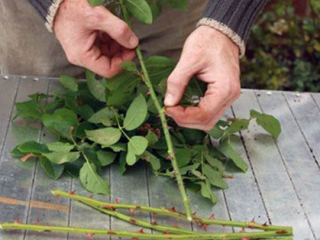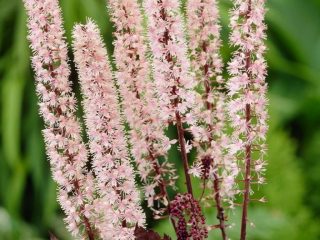Content
Just as large gems look better framed by small sparkling pebbles, tall flowers with bright inflorescences look more impressive surrounded by herbaceous greenery with small leaves or buds. One of these companion flowers is gypsophila, a herbaceous plant for open ground. This unpretentious garden crop has several varieties and is successfully grown on almost all continents of the Earth. Gypsophila is used to frame ridges and borders, in the complex design of flower beds and flower beds; its graceful branches complement bouquets and flower arrangements.
Photos and descriptions of gypsophila paniculata, rules for planting and care are given in this article. Here we will talk about popular plant varieties, list its strengths and methods of propagation.
Characteristics and types
Gypsophila is a herbaceous plant from the Clove family. In nature, the flower grows mainly on the southern continents and in warm countries. But among the one hundred and fifty plant species, there are several perennials that thrive in continental climates with frosty winters.
The plant has several other names, but the most popular ones are "Tumbleweed", "Roll" and "Baby's Breath". Today, more than a hundred species of gypsophila and several dozen cultivated varieties are known for growing in the garden.
Not all types of plants are popular with gardeners, The most famous are:
- gypsophila graceful, which is a spherical shrub about half a meter high with small inflorescences;
- swing creeping – ground cover plant up to 30 cm high with small but abundant flowers;
- paniculate gypsophila – a perennial species, growing up to 120 cm, with ball-shaped bushes;
- gypsophila splinter-shaped - a carpet of tightly intertwined stems and snow-white flowers, with a maximum height of 8-10 cm.
It is the paniculate variety that will be considered in more detail. This species has earned its popularity primarily due to its long-term life cycle - the flower does not need to be planted every year.
Description and varieties
Gypsophila paniculata has the following characteristics:
- a semi-shrub plant with a height of up to 100-120 cm;
- the bushes take on the shape of a ball (that’s why the flower is called a tumbleweed);
- stems erect, practically leafless;
- shoots are covered with greenish bark;
- the root system is powerful, tap-type;
- leaves are entire, oval or lanceolate, very small;
- The color of the leaves is grayish-green, there is a small fluff;
- inflorescences loose, paniculate;
- the flower is a bell-shaped cup of five wide petals;
- on the petals you can see a vertical bright green stripe;
- there are ten stamens in the center of the flower;
- the structure of the flower can be either simple or double;
- the diameter of the inflorescences is, on average, 6 mm;
- the color of the flowers is predominantly white, there are varieties with pink inflorescences;
- the fruit of gypsophila is a single-locular achene in the shape of a ball, which, after ripening, opens and independently scatters seeds;
- seed germination persists for two to three years;
- The flowering of paniculate gypsophila begins at the end of July or in the first days of August, and lasts about one and a half months;
- The plant is very unpretentious, loves loose and well-drained soil, needs a lot of light, rarely gets sick and does not attract pests.
There are not many varieties of gypsophila paniculata, the most famous of them are:
- Snowflake – a low shrub, growing up to 0.5 m, having snow-white double flowers;
- Flamingo with soft pink dense inflorescences and bush height up to 120 cm;
- White Holiday – a compact plant, no more than 45 cm in height, shaped like a neat ball and blooming with white inflorescences;
- Pink Holiday equally compact, but with a different shade of flowers, suitable for planting in flowerpots and boxes.
The variety of gypsophila varieties may seem sparse to some, but this plant is designed to frame other, more showy flowers, so it should not outshine its neighbors with bright colors and fancy shapes.
Reproduction of tumbleweeds
Growing gypsophila paniculata at home is not a difficult task, but requires minimal gardening skills. There are several ways to propagate this flower:
- Seeds.
- Seedlings.
- Cuttings.
- Vaccination.
But vegetative methods (grafting and cuttings) are useful only to experienced gardeners involved in breeding especially valuable varieties of this plant.
Seedlings of perennial varieties
Gypsophila paniculata is a perennial, so it most often reproduces through seedlings. You can grow seedlings of this flower at home; this is done in the same way as with garden crops or other flowers.
The best time to sow tumbleweed seeds is mid-March, because in order to get stronger, the seedlings will need at least one and a half to two months. To grow paniculate gypsophila, you need to prepare spacious, deep boxes or containers.
Containers for seedlings are filled with a suitable substrate: the soil should be loose, well-drained, nutritious, deoxidized. A homemade mixture of garden soil, peat, humus and sand is quite suitable, to which, if necessary, dolomite flour or quicklime is added.
The substrate is laid out in planting boxes and leveled - the layer should be quite thick. Now the soil needs to be moistened with a spray bottle. The seeds are laid out or scattered over the surface of the soil, and sprinkled with a half-centimeter layer of dry soil on top.
Now cover the container with a transparent lid, film or glass and leave it in a warm, bright place at room temperature.After 10-14 days, gypsophila shoots should appear.
How to care for seedlings
After the gypsophila seeds germinate and green sprouts appear on the surface of the soil, you must do the following:
- Thin out the flower seedlings so that there is at least 15 cm between the sprouts. This can be done in two ways: tear out unnecessary plants or pick all the sprouts into individual containers.
- Remove the cover from the container and place it in a cooler place.
- Provide gypsophila seedlings with 13-14 hours of daylight, using fluorescent or phytolamps.
- Regularly moisten the seedlings, but do not allow water to stagnate.
- Before planting in the ground, harden paniculate gypsophila by taking boxes with seedlings to the balcony or opening a window.
Other methods of reproduction
Growing from seeds is not the only method of propagating tumbleweeds. Very valuable densely double varieties of paniculate gypsophila are recommended to be propagated vegetatively - this way the qualities of the mother plant are better preserved.
In early spring or in the first days of August, it is necessary to cut the tops of gypsophila into cuttings. The cuttings should be rooted in loose soil with the addition of lime or chalk. It is necessary to bury the shoot 2 cm into the ground and leave it at room temperature and good lighting.
Tumbleweed cuttings are planted in a permanent location in the fall.
Landing in the ground
Planting and caring for gypsophila is not a difficult task, but here you need to take into account the long-term life cycle of the plant and approach the process thoroughly. You should choose a suitable place for the flower. This should be an area that is well lit by the sun, located on flat ground or on a small hill, and does not have groundwater close to the surface.
Seedlings are planted according to the 70x130 pattern, without burying the root collar of the plants underground. Gypsophila will begin to bloom after the growth of 12-13 pairs of leaves, and the plant will reach the peak of its beauty only at the age of three.
Tumbleweed Care
Paniculate gypsophila is one of those plants that may not require care at all. However, if flowers are grown for cut flowers and play an important role in landscape design, the owner will be interested in the highly decorative appearance of paniculate gypsophila and the large size of its inflorescences.
Here's how to care for gypsophila:
- water only during periods of severe drought, pouring water strictly at the root;
- two years after planting, thin out the bushes, leaving only every second of them (if this is not done, the inflorescences will be small and undecorative);
- Feed the bushes twice a season, using mineral fertilizers in the spring, and organic matter (humus, wood ash, etc.) before winter;
- Rot and nematodes pose a danger to gypsophila, so it is important to follow the watering regime, avoid waterlogging of the soil, and treat the bushes with phosphamide and fungicidal preparations a couple of times a season;
- in the fall, after flowering, you can collect tumbleweed seeds, after drying them and placing them in paper boxes;
- at the end of autumn, the bushes are pruned, leaving 3-4 longer shoots at the root, and the flowers are covered with dry foliage, sawdust or spruce branches.
Paniculata gypsophila is a frost-resistant plant; it can freeze out only if there is a snowless but cold winter or in an unstable climate with temperature changes and high humidity.
Conclusion
Photos of bouquets and compositions with delicate gypsophila prove the importance of herbaceous plants - without them, a flowerbed risks looking like a clumsy, shapeless spot. Subshrubs with snow-white or pink flowers look neat in the garden; thin branches effectively complement bouquets.
Growing tumbleweed at home is not difficult, because the plant is unpretentious and can reproduce in several ways.
